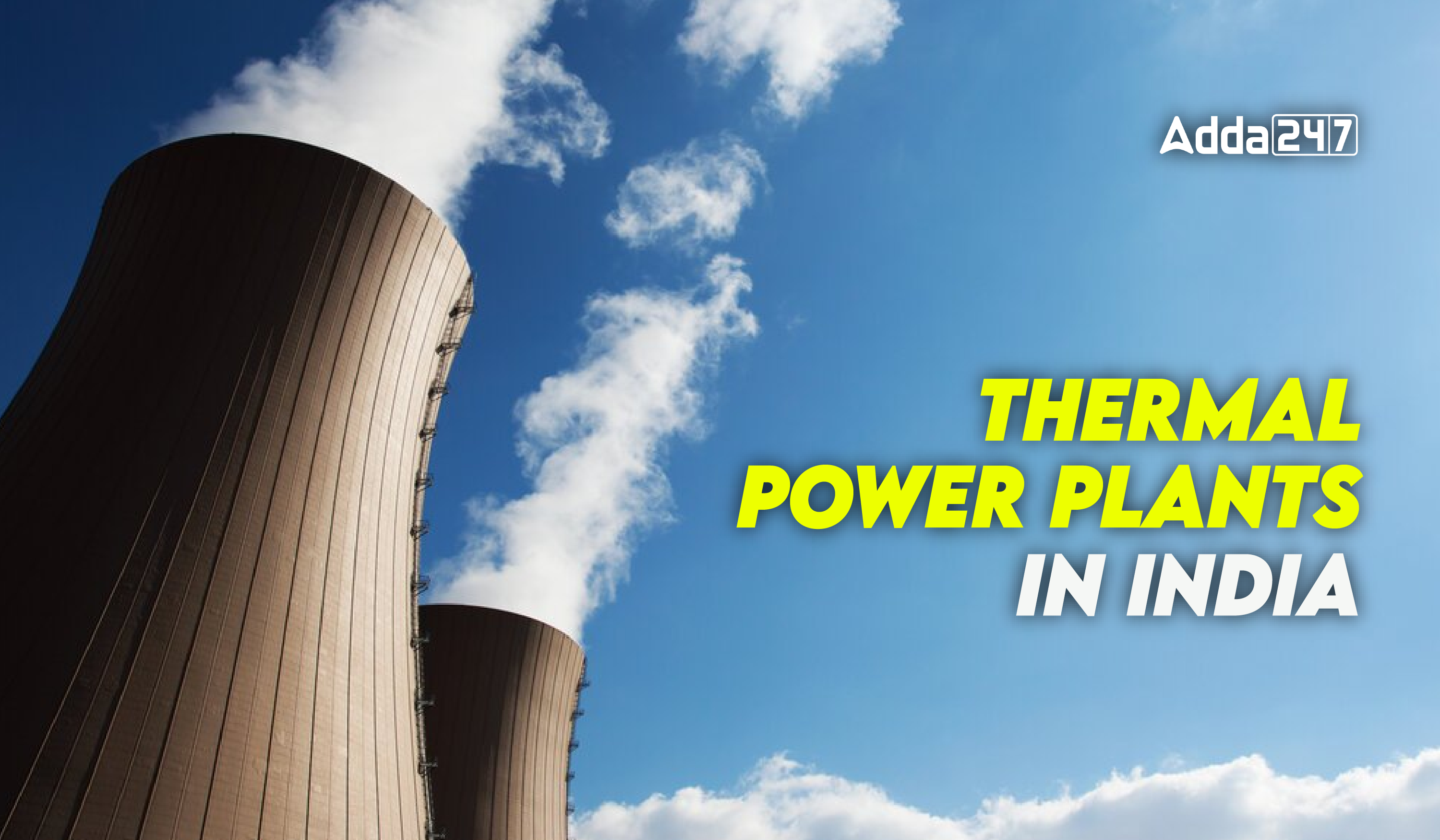Table of Contents
Thermal power plants, alternatively referred to as combustion power plants, operate by harnessing the energy produced by a steam boiler fueled by biomass, natural gas, coal, or heating oil. This steam triggers a turbine, which, in turn, drives an alternator to produce electricity. Electricity transmission is more efficient compared to transporting coal or petroleum over similar distances. India’s thermal power plants play a pivotal role in generating electricity nationwide.
Thermal Power Plant: What Is It?
A thermal power plant functions as a mechanism to convert thermal energy into usable electrical power for residential and commercial purposes. Through steam-operated turbines, heat is initially transformed into mechanical energy, and subsequently into electrical energy during the electricity generation process. These plants harness the heat energy derived from the combustion of solid fuels, primarily coal, to generate steam at elevated pressure and temperature. This steam, in turn, drives the turbine shaft connected to the generator, facilitating the conversion of kinetic energy from the turbine impeller into electric energy.
Thermal Power Plant Types
Thermal power plants use heat from a fuel source to create electricity, as the name suggests. Typically, the heat produces steam in a boiler, which powers a steam turbine that is connected to a generator. They are categorized as follows based on the heat source:
1. Coal Power Plant
The energy source for coal-fired thermal plants was coal. Renewable energy sources like wind, solar, biomass, and hydropower are used in addition to traditional energy sources like thermal, nuclear, and hydropower to produce power in India. Although a significant amount is generated, coal-fired thermal power plants generate about 75% of the total electricity produced.
2. Natural Gas Power Plant
Gases or oils are used as fuel in gas thermal power plants. Gas-fired power stations, also referred to as natural gas power plants, are thermal power plants that use natural gas as fuel to generate electricity. With 31 gas-based plants, 14.3 GW of India’s 24.824 GW developed capacity for gas-based energy.
3. Thermal energy Power Plant
Geothermal power stations employ underground fluids to produce heat. Some 340 geothermal hot springs are estimated to exist in India, according to the Geological Survey of India. Regarding direct heat applications, the majority of them are perfect because of their low surface temperatures, which range from 37 to 90 degrees Celsius. Soon, in Ladakh, India will establish its first geothermal power plant.
4. Biomass Power Plant
Various materials such as bagasse, rice husk, straw, cotton stalk, coconut shells, soy husk, etc. are used to produce heat using biomass thermal power. India has long relied heavily on biomass as a source of energy. It is abundant, renewable, carbon-neutral, and has the potential to greatly boost jobs in rural areas. Furthermore, biomass can generate consistent energy.
5. Nuclear Power Plant
Nuclear fission is the source of heat produced by nuclear power plants, and the operation phase of a nuclear power plant usually lasts the longest during its whole cycle. Asia’s first nuclear reactor is the Mumbai-based Apsara Research Reactor. India currently has 22 nuclear power reactors with an installed capacity of 6780 MegaWatt electric power operating in 7 states.
The three primary categories of thermal power plants used in India are indicated here, along with their installed capacities.
| India Thermal Power Plant Types | |
| Category | Capacity(MW) |
| Gas | 206404.50 |
| Coal | 24956.51 |
| Liquid | 509.71 |
Factors Affecting Thermal Power Plant Location
Steam plays a crucial role in thermal power plants as it serves as the primary medium for generating energy. Consequently, these power plants are strategically located in areas where essential resources like fuel and raw materials are abundant and easily accessible to ensure uninterrupted energy production. When selecting sites for the establishment of thermal power plants, various socioeconomic and engineering factors are carefully considered to optimize the design, construction, and operational efficiency of these facilities. Here is a brief overview of some of the key factors influencing the location decisions for thermal power plants.
- Fuel availability in the terrain, such as coal, water availability
- Closeness to major population centers
- Availability of supplies and raw materials
- Facilities for transportation
- Manpower availability
- Infrastructure
- The site’s size
List of Thermal Power Plants in India
In India, thermal power plants play a vital role in meeting the country’s electricity demands. Here is a comprehensive list of some prominent thermal power plants across India:
| State-Wise List of Thermal Power Plants in India | |
| State | Thermal Power Plant/Station |
| Delhi |
|
| Haryana |
|
| Jammu and Kashmir |
|
| Punjab |
|
| Rajasthan |
|
| Uttar Pradesh |
|
| Chattisgarh |
|
| Gujarat |
|
| Madhya Pradesh |
|
| Maharashtra |
|
| Andhra Pradesh |
|
| Karnataka |
|
| Tamil Nadu |
|
| Jharkhand |
|
| Odisha |
|
| West Bengal |
|
India’s Top 10 Largest Thermal Power Plants
Five of India’s ten largest thermal power plants, which are all coal-fired, are owned and operated by the government-run National Thermal Power Corporation (NTPC). Nonetheless, the government and the private sector both run thermal power facilities.
- Madhya Pradesh’s Vindhyachal Thermal Power Station
- Gujarat’s Mundra Thermal Power Station
- Gujarat’s Mundra Ultra Mega Power Plant
- Talcher Super Thermal Power Station, Odisha
- Tiroda Thermal Power Plant, Maharashtra
- Sasan Ultra Mega Power Plant, Madhya Pradesh
- Uttar Pradesh’s Rihand Thermal Power Station
- NTPC Dadri, Uttar Pradesh
- Chandrarapur Super Thermal Power Station, Maharashtra; and
- Sipat Thermal Power Plant, Chhattisgarh
Benefits of Thermal Power Plants
Here is a list of a few benefits of thermal power plants.
- Fuel is very inexpensive.
- The production of energy is simple.
- Less expensive to start up.
- Require less space.
- Has less power generation costs.
- Can be erected anywhere.
The Drawbacks of Thermal Power Stations
- Not very efficient
- Have higher operational expenses.
- High maintenance expenses are associated with thermal power facilities.
- Need a lot of water to convert their water streams.
India’s thermal power plants play a significant role in the nation’s social and economic infrastructure. Their responsibility lies in producing electricity, a vital component for human survival. Most of the electricity produced in India comes from coal-based power plants. India is still making a significant contribution to the high output of thermal power plants despite the coal crisis.



 TSPSC Group 1 Question Paper 2024, Downl...
TSPSC Group 1 Question Paper 2024, Downl...
 TSPSC Group 1 Answer key 2024 Out, Downl...
TSPSC Group 1 Answer key 2024 Out, Downl...
 UPSC Prelims 2024 Question Paper, Downlo...
UPSC Prelims 2024 Question Paper, Downlo...





